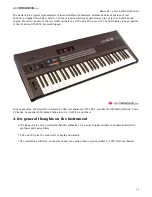
A wavetable is a list of references to up to 64 waves, in between you can move randomly.
Creating own Wavetables
Sooner or later you want to create your own wavetables and waves. The user interface of
the MicroWave II/XT/XTk is not effective for doing such complex things. Therefore we refer
to corresponding computer software products.
Nevertheless we would like give you a short introduction into the basics of creating
wavetables.
The biggest part of the MicroWave II/XT/XTk’s wavetables contain between 8 and 16 waves,
some of them consist of fewer, some have more. As you can see, you don’t need to fill all
positions of a wavetable with waves to get interesting sweeps. Take your wavetable editor
and look into some of the ROM wavetables. E.g. wavetable 01 is made up of very few
waves while wavetable 28 contains a lot of them.
When you want to create a wavetable that simply fades from a pulse wave to a sawtooth
waveform, you need exactly two waves: The first one, a pulse wave, on position 00 and the
second one, a sawtooth wave, on position 60.
Look into the ROM waves. Consider these waves as a big collection for your own
wavetables. E.g. you will find a sawtooth, a pulse, a triangle and a sine wave already there.
So you can construct a whole new wavetable out of the ROM waves.
History
At the end of 1970, Wolfgang Palm, the founder of PPG, had the idea of recreating the
sound and behaviour of analog circuitries through a digital representation of oscillator
waveforms with different filter settings. He then stored these waveforms sequentially into a
so-called wavetable and added features to scan through this wavetable by envelope, LFO
and the like. The result was a sound that changed its timbre without using any kind of
analog filtering or other processing like FM or ring modulation. These individual timbre
changes that were different from anything else known at that time made up the typical
"wave sound". The first synthesizers built in the early 80s that used this technique were the
PPG 340/380 - Wave Computer and the PPG 360 Wave Computer. Both models yet
without analog filters.
Wolfgang Düren, responsible for the distribution of the PPG synthesizers at that time, was
able to convince Palm to set up analog filters after the oscillators on the follow-up models
PPG Wave 2 and PPG Wave 2.2. The result was synthesizers that wrote history and
influenced the sound of a whole generation.
In the late 80s, PPG discontinued their work and therefore the production of the Wave, but
in the meantime Wolfgang Düren, now manager at Waldorf Electronics, initiated the rebirth
of the Wave’s technology. Based on an extensive cooperation contract with Wolfgang Palm,
the Waldorf MicroWave became the official successor of Wave technology in 1989. The
MicroWave was one of the most influental synthesizers of the late 80s and the 90s, right up
to today. You can find it on almost any important music production from disco through pop
and rock to experimental music. However, the availability of this great synthesizer was not
as immediate as was needed, so it was decided in 1995 to further enhance it and to only
use those electronic parts that we knew were available. This led to the idea of developing
digital filters, and we think we’ve done a pretty good job.
However, we have not forgotten the past: you can still find the original wavetables of the
PPG Wave Computer (Wavetables 001…008), of the PPG Wave 2.2 (009…030, plus the
first 8 wavetables) and of the classic MicroWave (031…064, plus 001…030) in the
MicroWave II/XT/XTk, ensuring that you can still create all famous sounds of those times.
User’s Manual MicroWave II • MicroWave XT • XTk
37
Содержание MicroWave II
Страница 1: ...Bedienungsanleitung User s Manual ...
Страница 2: ......
Страница 123: ......
Страница 125: ......
















































